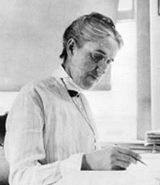

 | | 
|
|---|

 1902 was not a year that provided much opportunity for a woman with a good mind and a gift for science, particularly not a deaf woman. Deafness closed the door on two of the professions open to her gender: teacher or nurse. However, Edward Charles Pickering became the director of Harvard College Observatory in 1877 at a time when the collection of data far exceeded the capability of his staff of "computers" to catalogue. To solve his problem, he doubled his staff by hiring women at less than half the wage of men ($0.25 an hour).
1902 was not a year that provided much opportunity for a woman with a good mind and a gift for science, particularly not a deaf woman. Deafness closed the door on two of the professions open to her gender: teacher or nurse. However, Edward Charles Pickering became the director of Harvard College Observatory in 1877 at a time when the collection of data far exceeded the capability of his staff of "computers" to catalogue. To solve his problem, he doubled his staff by hiring women at less than half the wage of men ($0.25 an hour).
Henrietta Leavitt (a young woman who had attended Oberlin College and the Society for Collegiate Instruction of Women before a severe illness destroyed her hearing) joined his staff in 1902. One of Leavitt's tasks was to determine the magnitudes of stars, although there was not a standard at the time. She soon developed a standard of photographic measurement that was accepted by the International Committee on Photographic Magnitudes in 1913 and called the Harvard Standard. Her scale used logarithmic equations to order stars over seventeen magnitudes of brightness and was created using 299 plates from thirteen telescopes.
The achievement for which she is most noted enabled astronomers to calculate the distance to distant stars. In 1912, Leavitt found a way to determine the actual brightness of a certain type of star (known as the Cepheids). When the actual and apparent brightness of a star is known, its distance from earth can easily be calculated, since brightness decreases with the square of distance. Within the decade, Harlow Shapley used the Cepheid Variable Period-Luminosity relationship to produce the first map of the Milky Way.
Unlike Harlow Shapley, Henrietta was not allowed to choose what she studied. She was employed by Pickering as a computer, and as such, she discovered 10% of the 20,000 pulsating stars that we have currently mapped (half of all the known variable stars even in 1930). Despite the constraints of her career and its inherent lack of choice, she attained enough of a world-wide reputation that Professor Mittag-Leffler of the Swedish Academy of Sciences sent her a letter in 1925, declaring his intent to nominate her for the Nobel Prize in Physics the following year for her role in discovering the Period-Luminosity relationship. Harlow Shapley, the director of Harvard College Observatory at that time, was forced to reply that she had died of cancer in 1921.
Henrietta Leavitt was a member of Phi Beta Kappa, the American Association of University Women, the American Astronomical and Astrophysical Society, the American Association for the Advancement of Science, and an honorary member of the American Association of Variable Star Observers. Her early death was viewed as a calamity by her colleagues for reasons that extended beyond her achievements. As Solon I. Bailey noted: "She had the happy faculty of appreciating all that was worthy and lovable in others, and was possessed of a nature so full of sunshine that, to her, all of life became beautiful and full of meaning."
Website Sources:
http://www.womanastronomer.com/harvard_computers.htm
http://www.ias.ac.in/resonance/June2001/June2001p2-3.html
http://www.mada.org.il/website/html/eng/2_1_1-31.htm
http://cwp.library.ucla.edu/Phase2/Leavitt,_Henrietta_Swan@871234567.html
http://www.astro.livjm.ac.uk/courses/one/NOTES/Garry%20Pilkington/cepinp1.htm
http://hoa.aavso.org/posterswan.htm
— Written by Jackie Stewart